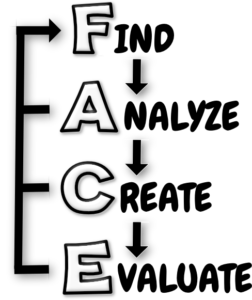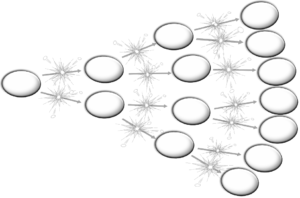PROBLEMS
Simply put, a Problem is when you FEEL that what you Have is not what you Want.
It stimulates you to ‘make a change” to FEEL better about THINGs. You want to take Action to turn your “imagined” Want into a THING you Have.

A Problem causes dissonance in your soul, and you need your harmony back.
When you get what you Want, it feels good. You gain pleasure.
It can be said, “Life is but a continuing series of Problems constantly handing you discord, to which you must Act to regain your peace.
Difficulties can trouble you and make you feel bad and upset. But they can also challenge and excite you, giving you drive and motivation.
Think about your day-
It’s full of minor problems (or challenges), a few modest ones, and maybe a couple of big ones. You may even be facing a few significant life challenges right now too.
Problems stand between you and your goals, and they frustrate you and knock you off-kilter. But you have an innate urge to solve them and get what you want.
Yet, any Problem is NOT only a set of circumstances!
Your PROBLEM is more how you FEEL about those circumstances.
The size of the gap between what you Have and what you Want equals the size of your Problem. How you FEEL about the size of that gap determines your desire to solve it.
THOT-WARE is all about helping you F.A.C.E. and resolve your problems. Use it!
Upon choosing a Problem to solve, you need first to understand it clearly. You have to define what you Have accurately and precisely know what it is you Want. You must identify all the pertinent FACTS.
But, the FACTS are only a set of THINGs, and they only become a Problem when they stir up your FEELINGS. If your situation doesn’t ignite any emotion, you still only have facts. Even when solving Word Problems or a Sodoku, you can’t do it without Feelings.
Not all Problems are bad, generating negative feelings. They often stir up positive Emotions, especially when you think of a Problem as a challenge or goal, and you get excited about fixing it. And it does feel good to fix it!
So understanding your Problem involves finding the FACTS and how they affect your FEELINGS. Sometimes you have FEELINGs, while the facts elude you. But your emotions will always have THINGs that cause them. (Remember the Thing-THOT-Feeling triad is at work.)
AN IMPORTANT POINT- To fix your Problem, you will either have to change the FACTs or change your “FEELINGs” or both. But some THING has to change!
If you never solve any of your Problems, you would expect to FEEL bad. So, use THOT-WARE to help navigate you through the process.

Solving ongoing problems (therefore getting better FEELINGs) is what makes life worth living!
Of course, you can also use THOT to avoid THINGs you don’t Want!
So Think about preventing Problems too; so you don’t get THINGs you don’t Want in your life.
- So, here is how you-
F.A.C.E. YOUR PROBLEMS
(with or without THOT-WARE)
- Find enough Facts and FEELINGs about your Problem so that you can fix it. [Also, while you’re looking for THINGs, find out how others have dealt with the same or similar problems.]
- Analyze the Facts and FEELINGs until you genuinely understand the pieces, how they connect, and the real cause of the problem.
- Create and evolve potential solutions that will get you the THINGs and FEELINGs you want.
- Evaluate your favorite solutions until you select the best one.
F.A.C.E. is the flow that powers THOT-WARE. You can quickly move through each step in your head, do it on a single sheet of paper, or take your time and use many sheets of paper. You are encouraged to go back to previous steps to gather more results. You can do the F.A.C.E. cycle quickly at each step of F.A.C.E. Stay flexible.
Use THOT-WARE as a handy companion for your already remarkable brain.

How long do you stay at each phase of the cycle? Until you feel you have done enough. Don’t stay too long, because you can always go back.
Thinking on paper is always the best way to think! (With or without using THOT-WARE.) But for smaller problems, you have permission to F.A.C.E. them just in your head.
Think through this process, using various THOT-WARE guides until you are ready to-
- Decide on a solution then,
- Do it!
Once you’ve Done what it takes, you have F.A.C.E.D. Your Problem!
Of course, after you have done it, you must verify that your problem is solved. You will know if you actually “got what you wanted,” or are still left with more work to do.
Or worse, another whole new problem has formed. If so, FACE that one too.
Let’s look at the F.A.C.E. THOT Process in more detail-
 (With a Mostly Open Mind.)
(With a Mostly Open Mind.)
FACTS and FEELINGS
Go on a search and find THINGs out about your Problem. Objectively investigate, discover, explore, detect, observe, research, and maybe even spy.
Determine the Facts that make up your Problem, at first leaving your emotions out of it (impossible to do, but do it the best you can.)
Then go back and objectively uncover the FEELINGs the facts evoked, without letting your emotional state get in the way, (the best you can anyway.) If your FEELINGs are too intense, maybe you should take a break and come back to it.
When other People are a part of your Problem (which may often be)
If your Problem involves other People’s FEELINGs, it makes it much more challenging. (Because they’re usually clashing with your own.)
It’s probably easier to see how other people FEEL (facial expressions, body language, slamming doors, etc.) than to know what THOTs about what THINGs are causing their FEELINGs. So you can guess if you want to, but if their emotional state is crucial to solving the Problem, you must confront and talk to them; to discover their THOTs and causes of their associated FEELINGs.

If you find yourself pointing your finger at others for being your Problem, “take a three times harder look at yourself” in trying to find the Facts. The revelation for this rule is in your hand. Only one finger points at the other person, and the other three fingers point right back at yourself. (And who knows what your thumb is pointing at!)
After you have a good grip on your Problem’s Facts and FEELINGs, you may benefit from finding out how others have solved this same or similar problems. You can look for and ask others what they did or query the internet.
If you don’t think any FEELINGs are involved, you’re wrong. Emotions you Find don’t have to be negative; they can be anywhere on the Emotions graph. But you do have FEELINGs in the game.
If you FEEL you Want something you don’t Have, it’s good FEELINGs driving your desire to solve your Problem.
Stay in the FIND mode until you think you have enough information to Analyze your Problem adequately.
“Catchy acronym, aye?”

 (With a Mostly Closed Mind.)
(With a Mostly Closed Mind.)
Logically perform Reality Checks on all your Facts and FEELINGs, then figure out the Real-Causes for what you Have that you don’t Want. Finally, make a list of what you need for your solution.
- Reality Checks
Take a critical look at all your Findings.
Scrutinize your Facts without the FEELINGs. Turn your Emotions off (the best you can.) Take a deep breath or three. Don’t let them affect clear thinking. Take each detail you found and verify it is-
Right
Is it factual or assumed? Make an effort to verify all your assumptions are correct. Remember that to ASSUME, quickly makes an ASS of U and ME!
Enough
Do you have all the Facts you need? Is something missing? Is some THING missing? Do some of the Facts need to be further broken down into more detail for better Analysis? Verify your Facts are everything you need.
True
Are any of your Facts false? Lies told by someone else, or harder to accept, lies you have told yourself? Verify your Facts are actual. Deal with reality as honestly as you can.
- Real-Cause Analysis
Examine how Facts interact with each other. Locate the cause and effect between them.
Become a Why-ner. Be a pain in the asking of “why!” Identify what indeed caused what and how far back it goes. Put together the Chain-of-Events. If it helps, work your way back to the first link in the “chain” that started the Problem. Many pieces can add up to be the Problem, not just one of them. Identify the ones that matter most.

Remember again; these are just Facts and nothing but the Facts. They alone are not your Problem, but the FEELINGs spawned by them created your discord.
So next, examine FEELINGs and how and where they make the Facts your Problem. Go back through the chain reaction and see how Emotions impact them.
This step is so much easier to do if you are only dealing with your own Emotional state. If other people’s FEELINGs are also part of your Problem, you’ve got a bigger job ahead of you, and it would be best if you involved them.
- Requirements List
When you’re winding up your Analysis, you should have all the pieces comprising your Problem (Have vs. Want) laid out before you, giving you the whole picture.
You understand:
- what caused what
- and why, and
- what’s needed and
- what’s not required.
Now you can make your Requirements list of “must-haves,” “must-not-haves,” and your “nice-to-haves.” It will help guide you as you Create the ideas needed to fix your Problem.
Others’ solutions
Compare your Problem to similar others’ problems you found in the Find step.
Do you need to back up and Find out more things?
Got enough? If so, you’ve got “what you need” to figure out how to get “what you Want.”
Be anal in your Analysis.
Next, with your understanding of the Problem and your Requirements List in hand. you are free to-
 (Mostly, Open your mind again.)
(Mostly, Open your mind again.)
Be like a child. Let go, and let your THOTs flow.
Think crazy. Think logical. Let your ideas rain down on paper. Seeing your captured THOTs will spark the ignition of more and better THOTs. Keep your “idea” rain pouring.
New THOTs arise from the fusion of other THOTs. These THOTs come from your conscious as well as your subconscious and super-conscious mind.
Take a break and quit thinking for a while. (Busy thinking can clutter your mind.) Do something fun! Clear your brain of old THOTs to let new and fresh ones enter.
The Find phase, with any luck, found similar problems and their solutions. Mix those ideas up with your own.
Take all those connected links from your Analysis and unlink them, throw them up in the air, and grab the appealing ones as they flitter back down. Mix in others’ ideas to assemble bold and novel approaches.
Don’t just write down words; draw pictures when you can.
If you will be making something to solve your Problem, embrace “sketch-storming” to grow and manifest your concept on paper.
Keep putting your THOTs on paper. Look at them upside down or with squinty eyes. Take a nap. Watch or read something funny. Laughing out loud clears cobwebs from your brain, and a respite revitalizes your originality.
Keep stirring in additional THOTs to help provoke new and more powerful possibilities.
Use THOT-WARE to help trigger your imagination.
Don’t limit yourself in this step. Feel free to fall back and review the Find and Analyze steps. Jump forward for a quick Evaluate session if it helps you better refine your ideas.
At the end of this step, you will have one solution you think is the one or several from which you must choose. Just don’t stop too soon. Keep creating until you have the “most excellent FEELING” about your solution or solutions.
You are finally ready to-
 (Mostly Close your Mind again)
(Mostly Close your Mind again)
It’s time to choose which of your potential Creations is the winner. (Of course, more than one can share the spotlight.) It is the time to be an astute and critical Judge and not jump to your conclusion too quickly.
Note the word “Value” is at the core of Evaluate. Use your Values to guide this phase. (You should have already questioned and answered your Beliefs about the Facts in the ANALYZE step.)
Look at each option. What’s good, bad, or interesting about each one? What are the risks of doing each one? Will it solve your Problem suitably?
Focus on the Values and FEELINGs you are seeking. How does each solution bring you the Emotions you Want? Is the choice in line with all of your Principles?
Compare each option and decide on the one that gives you the most Value for the least cost. Does it get you what you want in a cost-effective, efficient, legal, and elegant way? Does it satisfy all your requirements on your list? Does it meet your normally expected standards?
Trust your gut FEELINGs, but don’t ignore any of the Facts.
There’s THOT-WARE to assist in your decision.
If none of your solutions pass, go back a step or two or three and continue working through the F.A.C.E. process.
At the end of this phase, you must make a DECISION.
So now, the hardest part of all, you must-
You are finished Thinking and ready for Action!
Now Just Do it!
After you DO something to fix your problem, you have F.A.C.E.D. it. Feel good about it!
Once again: Thinking is not Action. None of the F.A.C.E. phases are taking Action. They are thinking. Don’t confuse thinking with Doing! Thinking is important, VERY IMPORTANT, but it alone will not solve your Problem. You must Act. Do what you decided, all the way to the end!
Your Action is the attempt you take to “change your world.” It will either alter the Facts (THINGs) that created your problem, change your FEELINGs about it, or sometimes both.
Make the changes you need to happen!
After you Do it, take a breath and decide if you “now Have what you Want” or if you still have the same or a new problem to solve.
By reading the previous three sections; Power of THOT, Power of FEELING, and PROBLEMS, you are fully equipped to put THOT-WARE to use.
